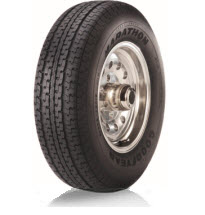joebedford wrote:
In another tire thread, some ... ummm ... person thought it was funny that I thought weight of a tire correlates to durability. When I asked to be filled in on what the joke was, I got no answer.
Anybody care to fill me in on the joke?
So here's the joke:
If you start with a clean piece of paper to design a tire, you can design a casing (the plies, beads, and belts) to be the same, then put different treads on top of that depending on what usage the tire is intended.
Some of those treads are going to be deep (lots of non-skid depth) and some are going to be shallow. Some tread widths are going to be wide, and some are going to be narrow. Some treads are going to be pretty solid (not much in the way of grooves and cross grooves) and some are going to be pretty open (much grooves and cross grooves). Again, it depends on what usage is intended for a tire - and of course, the weight of the tire would vary according to the amount of tread rubber.
I hope it is obvious that with the same casing, the durability would be the same (more or less) regardless of what is happening in the tread. The important thing here is that the casing - which is the key to durability - would be the same, but the weight would be all over the ballpark.
Let's pick a tire manufacturer - Goodyear is a good one because they offer a lot of different tires.
Then look at a particular tire type and size - How about an LT235/85R16.
Tire Rack lists 6 different tires:
1) Wrangler Silent Armor - 16/32nds non-skid depth - 46#
2) WR HT- 13/32nds - 50#
3) WR SR/A - 14/32nds - 43#
4) WR MT/R w/Kevlar - 19/32nds - 52#
5) WR DuraTrac - 18/32nds - 47#
6) WR DuraTrac - 18/32nds - 51#
(Yes, entries 5 and 6 seem to be identical. I suspect there was a recent change and both before and after versions are available, but they have different constructions - meaning differences in casing - but nothing published hints at what those differences are.)
Back on topic: I hope it is obvious that tire weight varies considerably and while the casing may also vary, the difference in weight caused by the casing would be small compared to the differences caused by the amount of tread rubber.
Let's take this a step further - and compare an ST tire:
7) ST235/80R16 Goodyear Marathon Load Range D - 10/32nds - 34#
8) ST235/80R16 Goodyear Marathon Load Range E - 10/32nds - 38#
First, notice that the difference in weights is 4# and that is purely the different in the casing. (OK, there's some rounding taking place here so we need to take that into account) But also notice that 4# is also the difference in entries #5 and #6 above - and that adds credence to my supposition that the difference is construction.
If we try to compare back to the larger tire size listed above (entries #1 through #6), we need to adjust the weight proportionally I'll do it by diameter, since most of a tire's weight is in the tread (31.7/30.7 = 103%), so the weights are adjusted upwards to 35# and 39#. - and if I further adjust the weights to the difference in non-skid depth (10/32nds up to 13/32nds) I get about 45# for the Load Range E - which puts it squarely in the range of the LT tires.
So that's the joke: There is so much variability in tire weights - and quite a bit is caused by differences in tread rubber - that trying to equate tire weight with durability is an exercise in futility.

